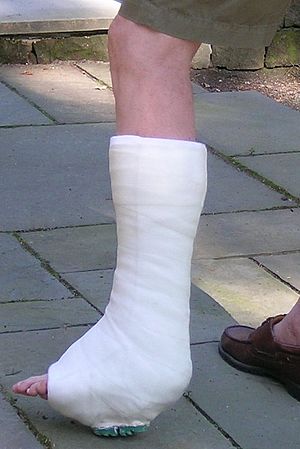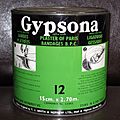Orthopedic cast facts for kids
A cast is like a strong, protective shield for a broken bone. When you break a bone, doctors use a cast to hold it perfectly still. This helps the bone heal straight and strong. Casts are usually made from plaster or a lighter material called fiberglass. Long ago, people used simple splints to help broken bones. Casts are a more advanced way to do the same job!
Contents
What are Orthopedic Casts?
Orthopedic casts are special coverings that doctors use to keep a broken bone from moving. They are very important for healing. When a bone breaks, it needs to stay in the right position. If it moves around, it might not heal properly. A cast acts like a firm, protective shell. It holds the broken bone steady while your body works to repair itself.
How Do Casts Help Bones Heal?
When you break a bone, your body starts a natural healing process. New bone cells begin to grow and connect the broken pieces. This process takes time. During this time, the new bone is very fragile. A cast prevents the broken bone from moving. This allows the new bone to grow without being disturbed. It helps the bone heal straight and strong. Without a cast, the bone might heal crooked or not at all.
Types of Casts and Materials
Casts come in different shapes and sizes. The type of cast depends on where your bone is broken. For example, a broken arm might need a short arm cast. A broken leg might need a short leg cast.
Casts are made from two main materials:
- Plaster of Paris: This is a traditional material. It starts as a powder mixed with water. It forms a thick paste that hardens when it dries. Plaster casts are strong and can be molded easily. They are often white.
- Fiberglass: This is a newer material. Fiberglass casts are lighter than plaster casts. They are also stronger and more durable. Fiberglass casts come in many different colors. This makes them popular with kids! They are also waterproof on the outside.
How a Cast is Applied
Applying a cast is a careful process. First, the doctor or nurse puts a soft, cotton sock or padding over your skin. This protects your skin from the hard cast material. Then, they wrap the plaster or fiberglass bandages around the injured area. They make sure the cast fits snugly but not too tightly. As the material dries, it becomes hard and firm. This creates the strong support your bone needs.
Living with a Cast
Having a cast can be a bit tricky, but it's important to take good care of it.
- Keep it dry: Most casts, especially plaster ones, must stay dry. Water can weaken the cast material. It can also cause skin problems underneath. If you have a fiberglass cast, some types can get wet. Always check with your doctor first.
- Don't stick things inside: It might be tempting to scratch an itch with a ruler or pencil. Don't do it! You could hurt your skin or push something inside the cast. This can cause infections.
- Watch for problems: Tell an adult if your cast feels too tight. Also, watch for numbness, tingling, or if your fingers or toes change color. These could be signs that the cast is too tight.
- Keep it clean: Try to keep the outside of your cast clean. This helps prevent germs.
When the Cast Comes Off
After several weeks, your bone will be healed enough for the cast to come off. Doctors use a special saw to remove casts. This saw has a dull, vibrating blade. It cuts through the hard cast material but won't hurt your skin. It can be a bit noisy, but it's safe. Once the cast is off, your skin might look pale and flaky. Your muscles might feel a bit weak. This is normal. Your doctor will give you exercises to help you get your strength back.
Images for kids
-
Short arm cast on a child.









